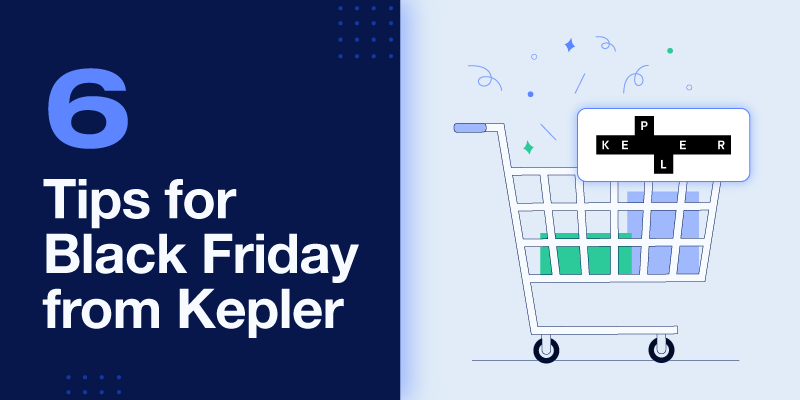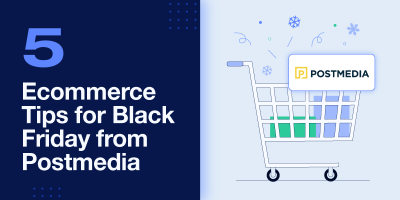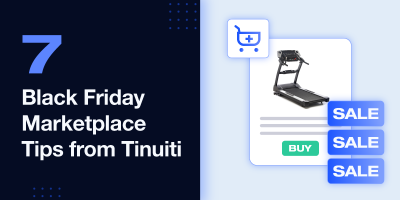With Black Friday and Cyber Monday swiftly approaching, ecommerce merchants must be prepared to crush Q4. We sat down with the team from Kepler to discuss some of the global marketing agency’s latest strategies and tips for a successful holiday season.
This is the first installment of our “Sell More on Black Friday” series; make sure you check out the contributions from Tinuiti and Postmedia for more great insights like the ones below.
1. A successful Black Friday strategy actually starts long before the holiday
It’s important to start building awareness and consideration by highlighting the holiday season and upcoming deals in video assets. Focus on reaching your target audience and building frequency early to increase the engaged audience and remarketing pools.
Once the week of Black Friday kicks off, shift your strategy to capitalize on the consumer who is ready to shop using active deal messaging that highlights product stories. Additionally, leverage your product feed to curate product sets of on-sale products, holiday deals, and top sellers. This strategy has been highly successful across Kepler’s retail clients.
For one client, launching early and building awareness allowed the team to spend 18% more on remarketing during Black Friday. Specific creative about “Daily Deals” encouraged consumers to act fast and drove 53% of the campaign’s revenue, double the result of the previous year.
2. Make sure you have enough budget to optimize your campaigns on existing channels before adding new channels
Small business vs. enterprise approach
The primary difference between the small and midsize business (SMB) and enterprise approaches is the scale of budgets. SMBs should be more strategic about how they focus their marketing dollars and split them between channels. It’s important to properly reach and target an audience and set minimum viable budgets for each channel.
Splitting the budget across too many channels reduces your ability to properly optimize within each campaign and to manage cross-platform frequency. Enterprise businesses should strive to hit the proper level of platform and audience saturation before launching on a new channel. You can diversify your media mix with larger budgets, but that increases the importance of a cohesive full-funnel cross-platform audience and creative strategy.
Lower-budget approach
For smaller budgets, pare down the scope of platforms and tactics to ensure the budget is not spread too thin. It is important to maintain a high enough frequency and conversion volume for ad recall and platform optimization.
Identifying the right audience and being able to target them precisely is crucial.
With the proper audience targeting and platform mix, the next decision becomes how and when to reach this audience. Kepler recommends focusing on awareness and consideration phases before the holiday season to reach new audiences who have never heard of your brand or solution, honing in on that niche but aligned target audience. This approach, paired with targeted remarketing during peak holiday or sales moments, can achieve desired results even with a smaller budget.
Higher-budget approach
Companies with larger budgets should take the same approach, but supplement those activities with additional audiences, platforms, and tactics. Audiences that may be less interested but are still relevant to the client can be included in the awareness and consideration phase to extend ad recall to a larger group. We also recommend using multiple platforms to reach users across their purchasing/media consumption journey.
Measuring performance is the key to getting the most out of your budget
Measurement is a key part of any brand’s media strategy. Adding more channels and diversifying media creates an added element of complexity to the measurement plan. We recommend a layered approach to measurement, depending on the size and complexity of the media programs for SMBs and enterprise clients. For larger, scaled programs, marketing mix models are increasingly valuable to measuring media channel influence and success.
3. Marketplaces should be treated differently than direct-to-consumer (DTC) sales channels
It is crucial to lean into the existing infrastructure of the marketplace, leveraging its promotional calendar and looking for co-branding and marketing opportunities. Each marketplace has a slightly different calendar of promotions leading up to, during, and after Black Friday. Work with the marketplace to understand the schedule and adjust your minimum advertised price policy to allow marketplaces to discount during those time periods.
Oftentimes, consumers shopping at marketplaces are less brand loyal than consumers shopping directly on a brand’s website. Familiarize yourself with opportunities from the marketplace to own more real estate on its website, leveraging email blasts, SMS, and live shopping events. Gaining more premium placements allows consumers to think about your brand before others once they are browsing.
Keep in mind, there are measurement limitations when working with marketplaces versus your own site. When selling through marketplaces, consumer data is owned by that third-party channel and is not accessible through your own CRM database.
4. Brand loyalty is weaker on Black Friday than any other time of the year
Consumers often use Black Friday as an opportunity to try new brands. With DTC-disruptor brands making large media investments to gain consumers’ attention, maintaining your brand presence during this shopping period is crucial. This requires focus on both customer retention and customer acquisition, as the latter is such a large factor in year-over-year growth.
Use different messaging for loyal customers and new customers.
Remind your current consumers why they love your brand and should continue to shop with you. Provide a discount for being a loyal customer to combat the discounts offered by competitors. For new customers, spend more time telling your brand story and demonstrating why customers love your products. Think about your purchase journey and work backwards.
The journey tends to be longer for more expensive items, as consumers do more product research.
Start messaging new customers at the beginning of the lifecycle and maintain their attention throughout the process with sequential messaging. The goal in late Q3 and early Q4 should be to build a pool of engaged users you can retarget later, especially if you can capture email addresses or phone numbers. In recent years, with tracking limitations and diminishing access to consumer data, the share of spend on remarketing has decreased, so capturing any user information is highly valuable.
By investing heavily in acquiring and engaging an audience early, you can shift your focus during Cyber Week to remarketing to engaged users who haven’t yet made a purchase. In an ideal Cyber Week scenario, you would dedicate 60% or more of your budget to remarketing and retaining your customers.
5. Sight and sound are key to breaking through to your customer, so focus on video
During Cyber Week, media platforms are flooded with ads, so think about what you can do with your creative to break through the clutter and stop shoppers from scrolling.
A balance of ad units is still key, as all users react to various ad types differently. Video is often the top performing ad type for engagement, but there may be some users who don’t have their sound on or don’t want to stop their music to listen to an ad. The key here is to pair video with shoppable or direct response-style creative that draws users in and gives them a quick and easy path to purchasing.
6. Be prepared to pivot
The holiday season is going to be unpredictable for the third year in a row, as the macro environment continues to impact consumer shopping behavior. Before the pandemic, you could use prior years to guide your planning, but each of the past two years has been very different. In 2020, stores were closed, and brands had to adjust to an all-online Black Friday and Cyber Five strategy. In 2021, stores were open again, but many consumers were still more comfortable shopping from home.
This year, brands are facing intense inflation that is impacting consumer spending. The only constant is that the pandemic has changed holiday shopping forever, forcing a higher reliance on online shopping and putting greater stress on the supply chain. Many consumers have already started their holiday shopping with large summer sales, especially with Prime Day returning to the summer.
In 2022, it’s important to plan for various avenues throughout the second half of the year. A flexible strategy is the best strategy, and being prepared to pivot at any time is a must. Leveraging a consistent measurement framework to answer key business questions should allow advertisers to optimize the strategy driving the most success.
We recommend that all advertisers set up Facebook’s Conversion API to close the gap in online signals and create a process to upload any store data from the brand’s storefront. It is crucial to discuss contingency plans ahead of time and set up processes that allow media buyers to flex budgets and strategies in real-time.
For example, if the data shows more consumers are choosing curbside pickup over shipping, be prepared to increase spend against ad formats that call out the curbside option and prioritize local inventory campaigns.

AVP, Commerce Lead
Jeff Giocondi is a Commerce Lead at Kepler. He works hands-on across Kepler commerce accounts and focuses on evaluating the evolving ecosystem to inform marketing innovation, vision, and best practices in commerce. Jeff’s client experience covers telecom, education, retail, auto, and more.




